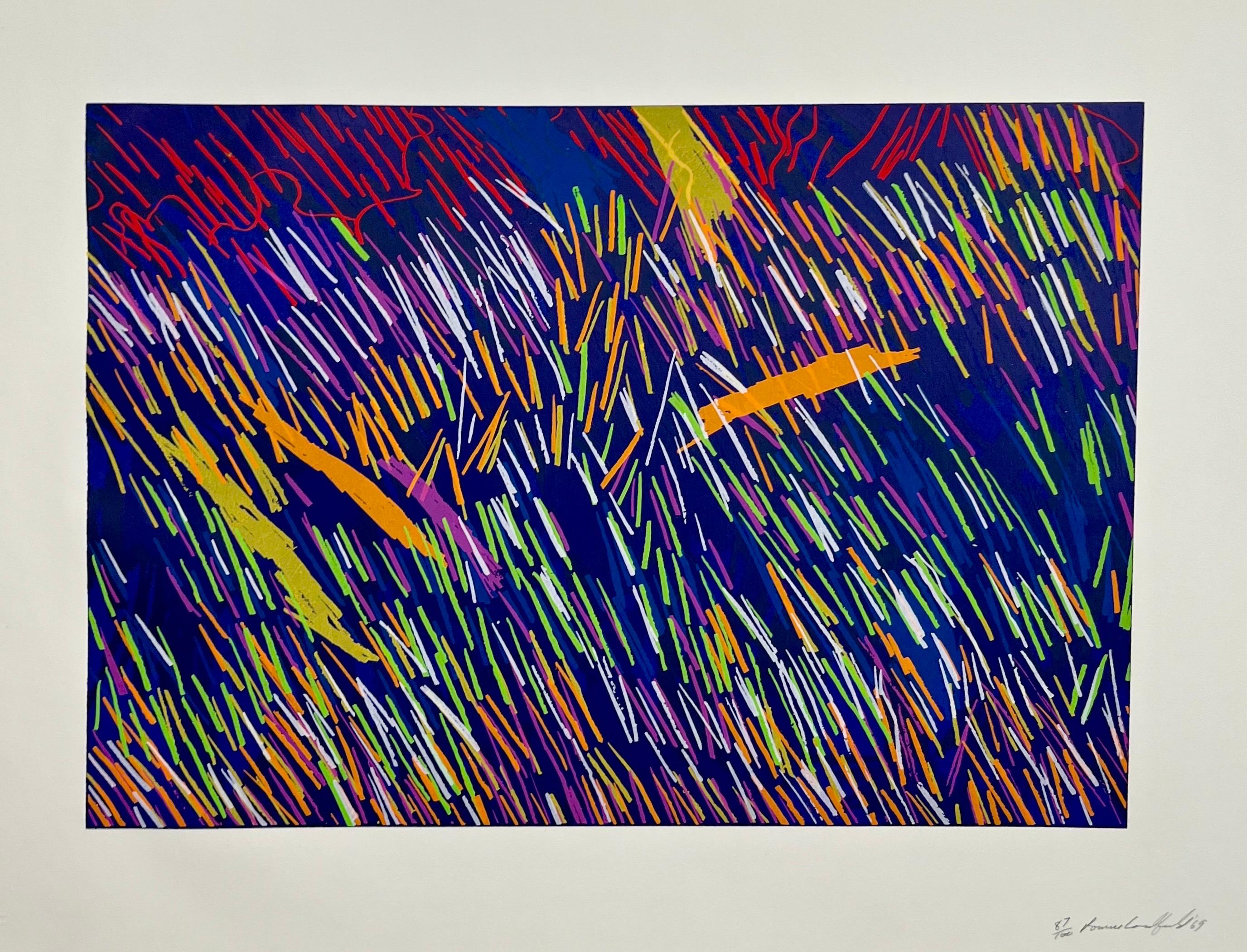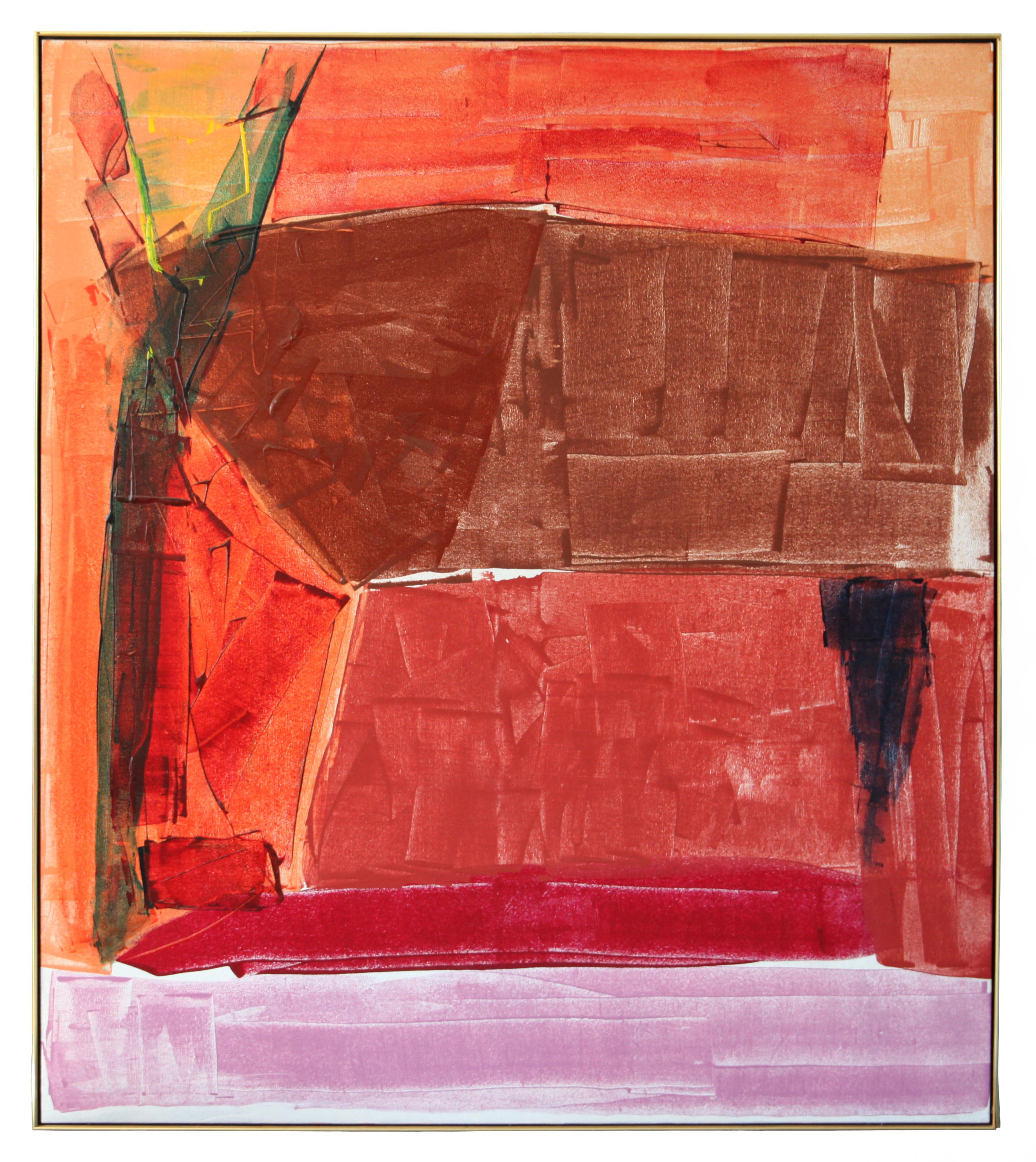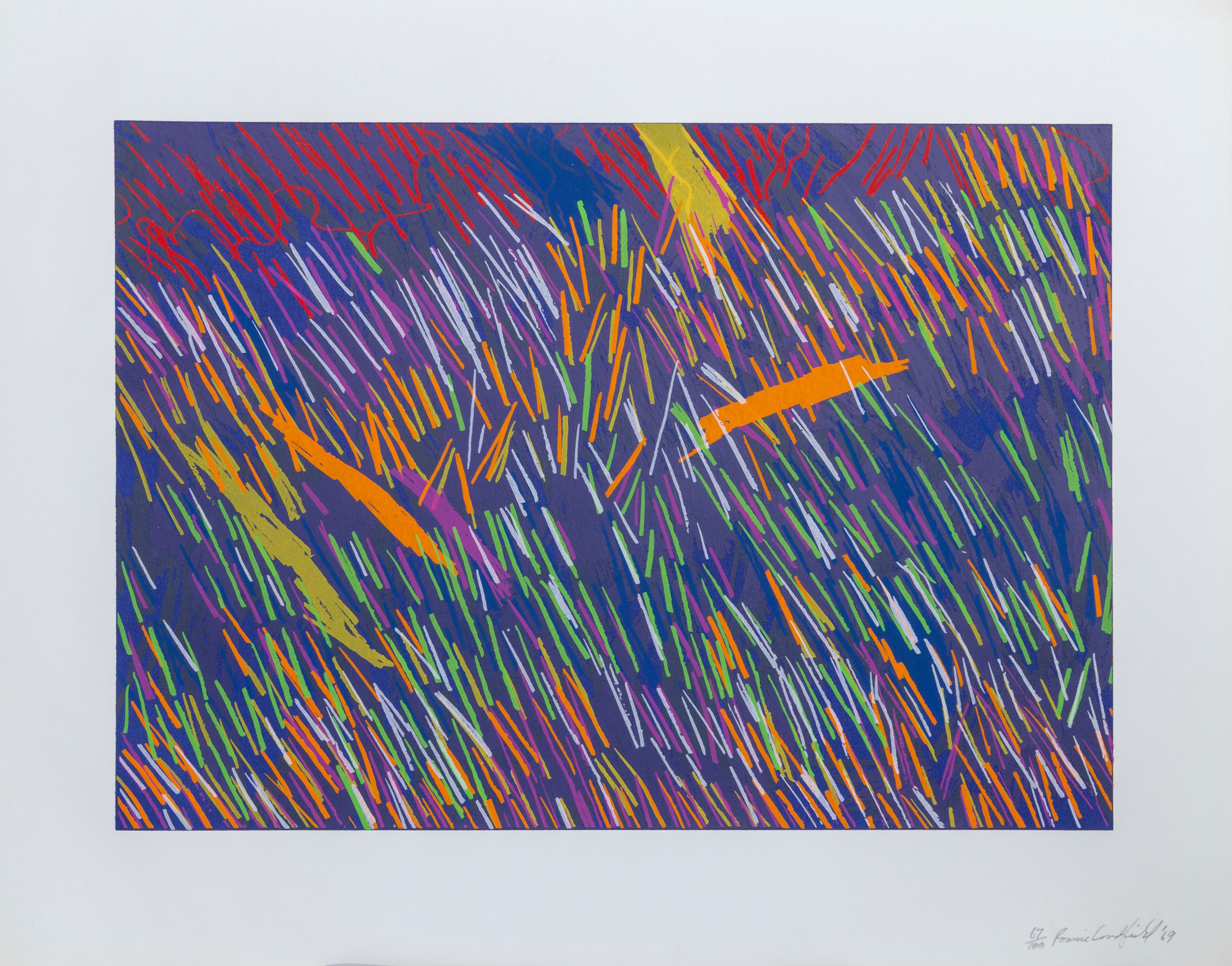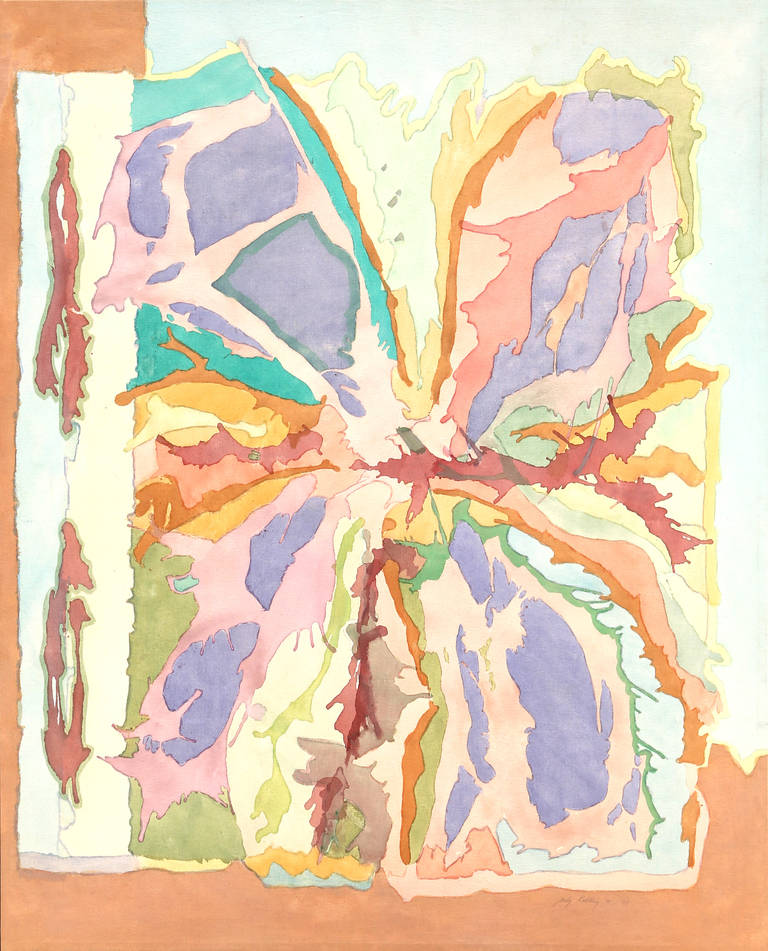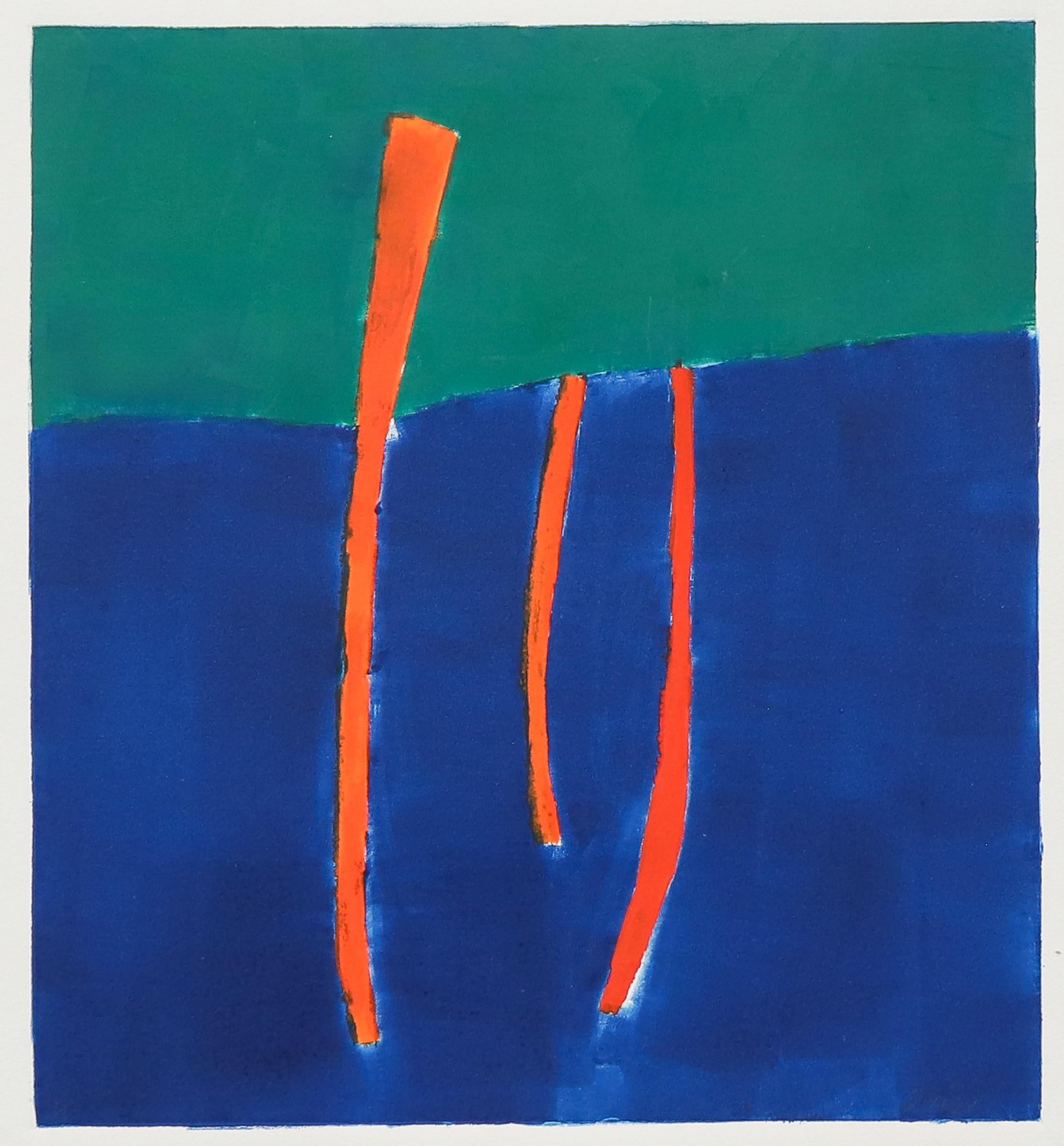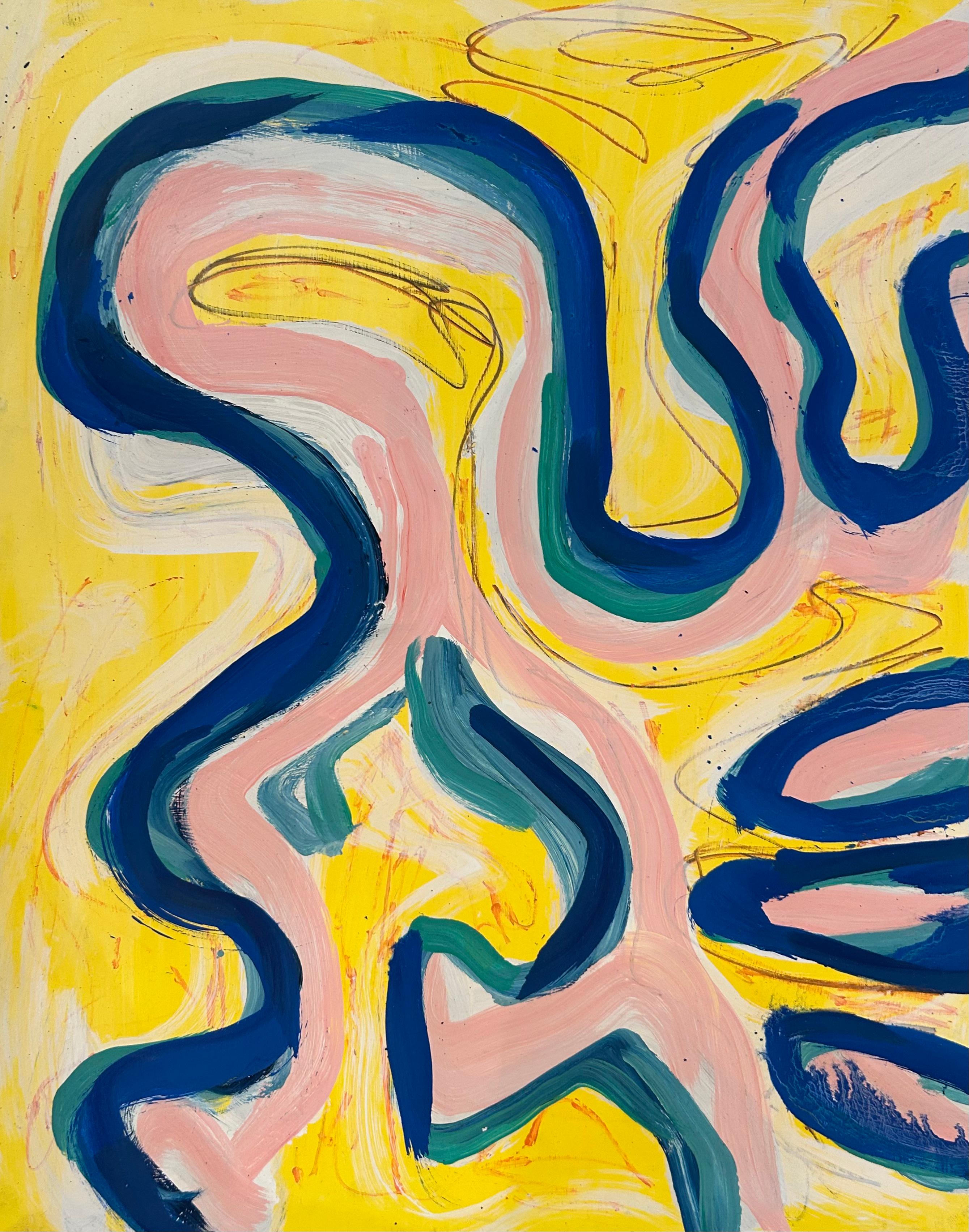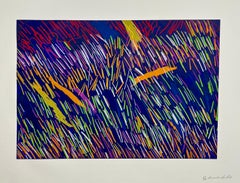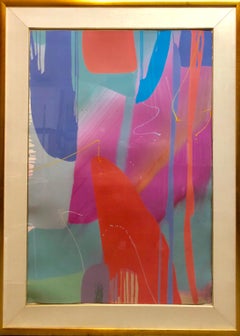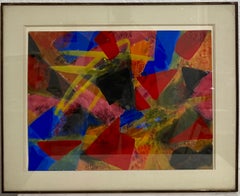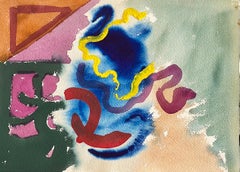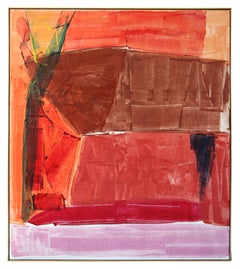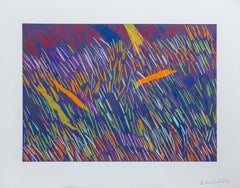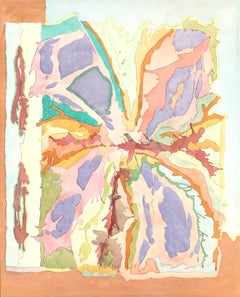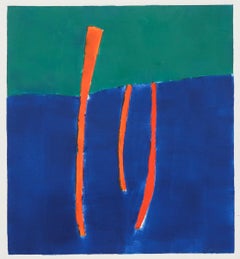Items Similar to Lyrical Abstraction Acrylic Painting Ronnie Landfield Color Field Abstract
Want more images or videos?
Request additional images or videos from the seller
1 of 8
Ronnie LandfieldLyrical Abstraction Acrylic Painting Ronnie Landfield Color Field Abstract1982
1982
$6,500
£4,924.98
€5,651.03
CA$9,146.55
A$10,054.57
CHF 5,284.22
MX$122,099.15
NOK 65,919.35
SEK 62,453.95
DKK 42,175.05
About the Item
Ronnie Landfield (1947- American)
"Untitled" 1982 Acrylic on Paper
Dimensions: Sheet 30" X 42" Frame 32 X 44
Hand signed and dated lower right
Provenance: Denman Associates, Seattle gallery
Ronnie Landfield (American, 1947-) is an abstract painter. During his early career from the mid-1960s through the 1970s his paintings were associated with Lyrical Abstraction (related to Postminimalism, Color Field painting, and Abstract expressionism), and he was represented by the David Whitney Gallery and the André Emmerich Gallery.
Landfield is best known for his abstract landscape paintings, and has held more than seventy solo exhibitions and more than two hundred group exhibitions.
Born and raised in Pelham Parkway in the Bronx, Landfield first exhibited his paintings in Manhattan in 1962. He continued his study of painting by visiting major museum and gallery exhibitions in New York during the early sixties and by taking painting and drawing classes at the Art Students League of New York and in Woodstock, New York. He graduated from the High School of Art and Design in June 1963. He briefly attending the Kansas City Art Institute before returning to New York in November 1963. At sixteen Landfield rented his first loft at 6 Bleecker Street near The Bowery (sublet with a friend from the figurative painter Leland Bell), during a period when his abstract expressionist oil paintings took on hard-edged and large painterly shapes. In February 1964, Landfield traveled to Los Angeles; and in March he began living in Berkeley where he began painting Hard-edge abstractions primarily painted with acrylic. He briefly attended the University of California, Berkeley and the San Francisco Art Institute before returning to New York in July 1965.
From 1964 to 1966 he experimented with minimal art, sculpture, hard-edge geometric painting, found objects, and finally began a series of 15 - 9' x 6' mystical "border paintings". After a serious setback in February 1966 when his loft at 496 Broadway burned down, he returned to painting in April 1966 by sharing a loft with his friend Dan Christensen at 4 Great Jones Street. The Border Painting series was completed in July 1966, and soon after architect Philip Johnson acquired Tan Painting for the permanent collection of The Sheldon Memorial Art Gallery in Lincoln, Nebraska.
In late 1966 through 1968 he began exhibiting his paintings and works on paper in leading galleries and museums. Landfield moved into his loft at 94 Bowery in July 1967; there, he continued to experiment with rollers, staining, hard-edge borders, and painted unstretched canvases on the floor for the first time. Briefly in 1967-1968 he worked part-time for Dick Higgins and the Something Else Press.
Landfield was part of a large circle of young artists who had come to Manhattan during the 1960s. Peter Young, Dan Christensen, Peter Reginato, Eva Hesse, Carlos Villa, William Pettet, David R. Prentice, Kenneth Showell, David Novros, Joan Jonas, Michael Steiner, Frosty Myers, Tex Wray, Larry Zox, Larry Poons, Robert Povlich, Neil Williams, Carl Gliko, Billy Hoffman, Lee Lozano, Pat Lipsky, John Griefen, Brice Marden, James Monte, John Chamberlain, Donald Judd, Frank Stella, Carl Andre, Dan Graham, Robert Smithson, Robert Rauschenberg, Andy Warhol, Kenneth Noland, Clement Greenberg, Bob Neuwirth, Joseph Kosuth, Mark di Suvero, Brigid Berlin, Lawrence Weiner, Rosemarie Castoro, Marjorie Strider, Dorothea Rockburne, Leo Valledor, Peter Forakis and Marisol were just a few of the artists and writers he befriended and saw regularly at Max's Kansas City - the favorite place for artists in New York City during the 1960s.
By 1970 Landfield was recognized as one of the first painters to have led the "movement away from the geometric, hard-edge, and minimal, toward more lyrical, sensuous, romantic abstractions in colors which were softer and more vibrant." His paintings were part of the Whitney Museum of American Art's Annual exhibitions in 1967 and 1969, and he was included in the first Whitney Biennial in 1973. During the late 1960s through the early '70s his work was included in group exhibitions at the Park Place Gallery, the Bianchini Gallery, the Bykert Gallery, the Sheldon Memorial Art Gallery, the Whitney Museum of American Art, the Museum of Modern Art, the Baltimore Museum of Art, the Studio Museum in Harlem, and the Iris & B. Gerald Cantor Center for Visual Arts (formerly Stanford University Museum of Art) amongst other places. In 1967-1968 two drawings were reproduced in S.M.S. III by the Letter Edged in Black Press, and he was included in New York 10 1969, a portfolio of prints published by Tanglewood Press.
In October 1969 he had his first one-man exhibition at the David Whitney Gallery in NYC, featuring works of that period which were partially inspired by Chinese Landscape painting. His painting Any Day Now, 1969, 108 x 93 inches was acquired by the Whitney Museum of American Art. His painting Diamond Lake 1969, 108 x 168 inches, was acquired from Philip Johnson by the Museum of Modern Art in 1972 and was installed in the lobby of MoMA for several months. His painting Elijah 1969, 108 x 55 inches was later exhibited in Beijing, China in the early 1990s; and it is currently on view in Havana, Cuba.
During 1970 Landfield participated in a three-person show in New York City at the David Whitney Gallery and he had solo exhibitions in Cleveland, St. Louis and in Corona Del Mar, California. In 1971 he held his second solo exhibition at the David Whitney Gallery in New York City. From that exhibition his painting Chinese Winter, 108 x 88 inches was acquired by the Rhode Island School of Design Museum of Art, and his painting Storm Thread, 108 x 94 inches, was acquired by the Smith College Museum of Art. Landfield joined the Andre Emmerich Gallery in April 1972 one month after the David Whitney Gallery closed in March 1972.
Landfield traveled throughout the southwest in 1973 and again in 1975. With his wife and artist friends Peter Young and Carmen Megeath he camped, lived and painted dozens of paintings on canvas and limestone in the mountains outside Zion National Park in southern Utah. He taught Fine Arts at the School of Visual Arts from 1975 until 1989. For ten years from 1975 until 1984 four of Landfield's paintings from the collection of Philip Johnson were installed in the Four Seasons Restaurant in the Seagram Building on Park Avenue between 52nd and 53rd Streets in Midtown Manhattan, on the so-called Mark Rothko wall.
Spending the early summer of 1980 on the Caribbean island of St. Barts Landfield produced a series of india ink and acrylic paintings on paper there. Throughout the later 1980s and 1990s he often spent summers in various towns throughout the western Catskill Mountains painting abstractions and abstract landscapes in oil paint and acrylic. During the 1980s and early '90s he showed his paintings with the Charles Cowles Gallery and Stephen Haller Fine Arts in New York City. During this period Landfield exhibited his paintings widely. He had solo exhibitions or was included in group exhibitions in Atlanta, Baltimore, Chicago, Houston, Los Angeles, Miami, New Orleans, Paris, San Francisco, Seattle, Washington DC and Zurich, to name a few places.
During the early 1970s to the early 1990s many of Landfield's major paintings entered important public collections. In 1970 his painting St. Augustine, 1968, 108 x 120 inches was acquired by the Norton Simon Museum in Pasadena; in 1971 Shenandoah (for Eva Hesse) 1970, 90 x 113 inches, was acquired by the Walker Art Center in Minneapolis; in 1972, his painting Rain Dance III, was acquired by the Hirshhorn Museum and Sculpture Garden in Washington, DC, and his painting From Portal to Paradise, 1982, 107 x 78 inches, was acquired by the Metropolitan Museum of Art in 1983, among dozens of others.
In 1994 Landfield presided over two public panel discussions at the New York Studio School and the Tenri Institute both in Manhattan called Cool and Collected or Too Hot to Handle. In 1995 he curated Seven Painters at the Nicholas/Alexander Gallery in SoHo, an exhibition that featured seven important abstract painters whose careers began in the mid to late 1960s, some of whom hadn't been shown for many years. In 1996 Landfield had a solo exhibition in Sapporo, Japan and lectured there on American art. In 1997 he aided colleague Ronald Davis creation of an educational website highlighting abstract art from the 1960s. He was represented by the Salander/O'Reilly Gallery in New York from 1997 until 2007. In October 2005 he had a solo exhibition of his paintings accompanied by a solo show of sculpture by Peter Reginato at the Heidi Cho Gallery in Chelsea.
In 2007 Landfield had a retrospective exhibition Ronnie Landfield: Paintings From Five Decades, at the Butler Institute of American Art. Later that year, he had an exhibition of recent paintings entitled Toward Monochrome at the Heidi Cho Gallery in Manhattan. Landfield has exhibited his work in important institutions and galleries for nearly five decades. Currently he lives and works in TriBeCa, and teaches at The Art Students League of New York. From 2007 until 2016, his work has been exhibited at the Stephen Haller Gallery in New York City and LewAllen Galleries in Santa Fe, New Mexico. He currently is represented by the Findlay Galleries in New York and Florida. He draws, paints and writes left-handed. Landfield's two sons are artists who live in New York: Matthew Hart Landfield is an actor, writer and director, and Noah Landfield is a painter and musician.
Collections
The Metropolitan Museum of Art
The Museum of Modern Art
The Whitney Museum of American Art
The Brooklyn Museum
The National Gallery of Art
The Hirshhorn Museum and Sculpture Garden
The Norton Simon Museum
The Art Institute of Chicago
The Museum of Contemporary Art, Chicago
The Los Angeles County Museum of Art
His work bears affinities both to Lyrical Abstraction and to Tachisme artists such as Nicolas de Staël, Serge Poliakoff, Andre Lanskoy, Hans Hartung, Jean-Paul Riopelle, Gustave Singier, Alfred Manessier, Roger Bissiere, Lyrical Abstraction arose in the 1960s and 70s, following the challenge of Minimalism and Conceptual art. Many artists began moving away from geometric, hard-edge, and minimal styles, toward more lyrical, sensuous, romantic abstractions worked in a loose gestural style. These "lyrical abstractionists" sought to expand the boundaries of abstract painting, and to revive and reinvigorate a painterly 'tradition' in American art. At the same time, these artists sought to reinstate the primacy of line and color as formal elements in works composed according to aesthetic principles – rather than as the visual representation of sociopolitical realities or philosophical theories." "Characterized by intuitive and loose paint handling, spontaneous expression, illusionist space, acrylic staining, process, occasional imagery, and other painterly techniques, the abstract works included in this exhibition sing with rich fluid color and quiet energy. Artists associated with Lyrical Abstraction include: Natvar Bhavsar, Lamar Briggs, Friedel Dzubas, Sam Francis, Ronnie Landfield, Pat Lipsky, Joan Mitchell, Robert Natkin, Jules Olitski, Larry Poons, Garry Rich, Larry Zox, Helen Frankenthaler and Morris Louis.
- Creator:Ronnie Landfield (1947, American)
- Creation Year:1982
- Dimensions:Height: 32 in (81.28 cm)Width: 44 in (111.76 cm)
- Medium:
- Movement & Style:
- Period:
- Condition:
- Gallery Location:Surfside, FL
- Reference Number:1stDibs: LU38214436922
About the Seller
4.9
Platinum Seller
Premium sellers with a 4.7+ rating and 24-hour response times
Established in 1995
1stDibs seller since 2014
1,810 sales on 1stDibs
Typical response time: 1 hour
- ShippingRetrieving quote...Shipping from: Surfside, FL
- Return Policy
Authenticity Guarantee
In the unlikely event there’s an issue with an item’s authenticity, contact us within 1 year for a full refund. DetailsMoney-Back Guarantee
If your item is not as described, is damaged in transit, or does not arrive, contact us within 7 days for a full refund. Details24-Hour Cancellation
You have a 24-hour grace period in which to reconsider your purchase, with no questions asked.Vetted Professional Sellers
Our world-class sellers must adhere to strict standards for service and quality, maintaining the integrity of our listings.Price-Match Guarantee
If you find that a seller listed the same item for a lower price elsewhere, we’ll match it.Trusted Global Delivery
Our best-in-class carrier network provides specialized shipping options worldwide, including custom delivery.More From This Seller
View AllLyrical Abstraction Screenprint Serigraph Ronnie Landfield Color Field Abstract
By Ronnie Landfield
Located in Surfside, FL
Ronnie Landfield (1947- American)
1969
Hand signed, numbered, and dated in pencil
Serigraph on handmade paper. With the blindstamp of the Tanglewood Press.
From the portfolio Various Artists that Included works by Alan Cote, David Diao, Ronnie Landfield, Lee Lozano, Brice Marden, William Pettet, Alan Shields, Kenneth Showell, Lawrence Stafford, and Peter Young. co-printed by Bank Street Atelier, Chiron Press, Fine Creations, Inc., Tom Gormley, Maurel Studios and S.D. Scott & Co., New York and published by Tanglewood Press, Inc., New York.
Ronnie Landfield (American, 1947-) is an abstract painter. During his early career from the mid-1960s through the 1970s his paintings were associated with Lyrical Abstraction (related to Postminimalism, Color Field painting, and Abstract expressionism), and he was represented by the David Whitney Gallery and the André Emmerich Gallery.
Landfield is best known for his abstract landscape paintings, and has held more than seventy solo exhibitions and more than two hundred group exhibitions.
Born and raised in Pelham Parkway in the Bronx, Landfield first exhibited his paintings in Manhattan in 1962. He continued his study of painting by visiting major museum and gallery exhibitions in New York during the early sixties and by taking painting and drawing classes at the Art Students League of New York and in Woodstock, New York. He graduated from the High School of Art and Design in June 1963. He briefly attending the Kansas City Art Institute before returning to New York in November 1963. At sixteen Landfield rented his first loft at 6 Bleecker Street near The Bowery (sublet with a friend from the figurative painter Leland Bell), during a period when his abstract expressionist oil paintings took on hard-edged and large painterly shapes. In February 1964, Landfield traveled to Los Angeles; and in March he began living in Berkeley where he began painting Hard-edge abstractions primarily painted with acrylic. He briefly attended the University of California, Berkeley and the San Francisco Art Institute before returning to New York in July 1965.
From 1964 to 1966 he experimented with minimal art, sculpture, hard-edge geometric painting, found objects, and finally began a series of 15 - 9' x 6' mystical "border paintings". After a serious setback in February 1966 when his loft at 496 Broadway burned down, he returned to painting in April 1966 by sharing a loft with his friend Dan Christensen at 4 Great Jones Street. The Border Painting series was completed in July 1966, and soon after architect Philip Johnson acquired Tan Painting for the permanent collection of The Sheldon Memorial Art Gallery in Lincoln, Nebraska.
In late 1966 through 1968 he began exhibiting his paintings and works on paper (painting, lithograph and silkscreen) in leading galleries and museums. Landfield moved into his loft at 94 Bowery in July 1967; there, he continued to experiment with rollers, staining, hard-edge borders, and painted unstretched canvases on the floor for the first time. Briefly in 1967-1968 he worked part-time for Dick Higgins and the Something Else Press.
Landfield was part of a large circle of young artists who had come to Manhattan during the 1960s. Peter Young, Dan Christensen, Peter Reginato, Eva Hesse, Carlos Villa, William Pettet, David R. Prentice, Kenneth Showell, David Novros, Joan Jonas, Michael Steiner, Frosty Myers, Tex Wray, Larry Zox, Larry Poons, Robert Povlich, Neil Williams, Carl Gliko, Billy Hoffman, Lee Lozano, Pat Lipsky, John Griefen, Brice Marden, James Monte, John Chamberlain, Donald Judd, Frank Stella, Carl Andre, Dan Graham, Robert Smithson, Robert Rauschenberg, Andy Warhol, Kenneth Noland, Clement Greenberg, Bob Neuwirth, Joseph Kosuth, Mark di Suvero, Brigid Berlin, Lawrence Weiner, Rosemarie Castoro, Marjorie Strider, Dorothea Rockburne, Leo Valledor, Peter Forakis...
Category
1960s Abstract Expressionist Abstract Prints
Materials
Screen
Monumental Texas Modernist Abstract Expressionist Color Field Acrylic Painting
By Lamar Briggs
Located in Surfside, FL
size is with frame. this is a very large piece.
Bright, vivid, large Abstract Expressionist color field painting. Similar in the manner of the colorful abstract works of Paul Jenkins...
Category
1980s Abstract Expressionist Abstract Paintings
Materials
Acrylic, Archival Paper
Richard Hennessy 1974 Colorful Vibrant Abstract Geometric Painting Modernist Art
By Richard Hennessy
Located in Surfside, FL
Painting on Paper
Hand signed and dated lower right
Frame measures 24.5 X 30.5 sheet is 18 X 24 inches
This piece has a jewel toned stained glass quality to it.
The artist Richard ...
Category
1970s Neo-Expressionist Abstract Paintings
Materials
Paint, Paper
Mod Abstract Expressionist Modernist Edward Avedisian Color Field Art Gouache
By Edward Avedisian
Located in Surfside, FL
Edward Avedisian Gouache Watercolor Abstract Painting on Arches paper. (notebook cover not included)
Unsigned, (bears name verso in pencil.)
Dimensions: 10" X 14"
Late 1970s, early ...
Category
1970s Abstract Expressionist Abstract Paintings
Materials
Watercolor, Gouache
Large Colorful 1980s New York Abstract Expressionist Oil Painting Joan Thorne
By Joan Thorne
Located in Surfside, FL
This is a large colorful, bold, vibrant original oil painting on canvas, hand signed and dated 1989.
It is titled Crete.
Joan Thorne (1943-) is a New York artist nationally and internationally recognized. A third generation Abstract Expressionist woman artist who has exhibited works over the past 30 years. Her art has been shown in the Corcoran Gallery of Art, Washington, DC, the Whitney Museum’s Annual Exhibition, the Grand Palais in Paris, and Barbara Rose’s seminal exhibition American Painting: The Eighties at New York University’s Grey Gallery.
Her recent shows in New York City have been reviewed by the New York Times, Art in America, ArtNews and The New Criterion among others. Her work has been compared to Elizabeth Murray work. It is colorful and has a 1980's, Memphis Milano feel to it.
Thorne grew up in Greenwich Village. Her mother was a Ukrainian immigrant from a musical family, who became an English teacher; her father, a surgeon. Recognizing their daughter’s artistic talents early, they enrolled her at age six in the Little Red Schoolhouse on Bleecker Street in Greenwich Village. Founded in 1921 by Elisabeth Irwin, a pioneer in educational reform, the school has continued to maintain its reputation as a progressive and nurturing catalyst for creative children. Pete Seeger, the folk singer, performed there so frequently that Thorne remembered him as if he were one of the teachers. In 1971, Thorne met Faith Ringgold (b. 1930) and joined her as a teacher at the Women’s House of Detention on Rikers Island in a new program called “Art without Walls–Free Space.” The program, which had been born from the civil rights movement, was aimed at enriching the lives of the inmates. Thorne and her peers came of age struggling against sexism in the art establishment and its attendant lack of exhibition opportunities for women. Since 1985, this issue had been loudly exposed by the public protests of the Guerrilla Girls, whose members remain a well-kept secret.
Her painting has been included in two Whitney Museum Biennials and various other museum group exhibitions both in the United States, Europe and Latin America.
She has had numerous one person shows in galleries such as: Sideshow Gallery New York, Fischbach Gallery, New York City, Corcoran Gallery of Art, Washington D.C., Willard Gallery, New York, Graham & Sons Gallery, New York, The Clocktower, New York City, and the National Arts Club among others.
Thorne has been awarded the Prix de Rome Fellowship to paint at the American Academy in Rome. She also received two National Endowment grants for painting and two Pollock Krasner Grants among others.
"Since 1973, while myriad styles, movements and mediums have flourished briefly in turn, Joan Thorne has steadfastly developed one visual language-that of painterly surface, light, color and distilled form-which she finds best suited for her artistic project: intimating dreams. intuitions and the psychic consequences of travel. "
"For there is something luxuriant and mysterious in Thorne's compositions. They have a classic modernist genealogy that encompasses Arthur Dove, Georgia O'Keeffe, Marsden Hartley, Milton Avery and Mark Tobey; yet each carries a hint of exoticism, "
--Richard Vine, Art In America, Review, June 1998
Education
Hunter College, New York, M.A.
New York University, New York, B.S.
Awards
2006 Adolf Gottlieb Foundation Grant in Painting
2003 Prize in Painting, Florence BiennaleInternazionale, Florence, Italy
2001 Pollock Krasner Foundation Grant in Painting
1986 Prix de Rome, American Academy in Rome
Pollock Krasner Foundation Grant in Painting
1983 National Endowment for the Arts, Fellowship in Painting
1980 New York State Council on the Arts, Grant for Painting
1979 National Endowment for the Arts, Fellowship in Painting
1976 Grant in Painting, Rhode Island State Council on the Arts
1975 New York State Council on the Arts, Grant for Painting
1974 Grant in Painting, Rhode Island State Council on the Arts
1972 Artist of the Year, Aldrich Foundation
Select Solo Exhibitions
2015 Black and White Into Color, National Arts Club, New York
2013 Sideshow Gallery, Williamsburg, NY
2005 Chris Winfield Gallery, Carmel, CA
2004 Klaus Steinmetz Arte Contemporaneo, San Rafael de Escazu, Costa Rica
2002 Feria de Arte International Arcale, Salamanca, España
2001 Andre Zarre Gallery, New York
2000 Retrospective: Museo Las Americas, San Juan, Puerto Rico
1998 A Retrospective: Museo Voluntariado De Las Casas Reales, Casa de Bastidas,
Santo Domingo, Dominican Republic
1990 1985 Graham Modern , New York City, NY
1989 1986 Ruth Bachofen Gallery, Santa Monica, CA
1986 William Halsey Gallery, Simon Center for the Arts, College of Charleston, Charleston, SC
1983 Lincoln Center Gallery, Lincoln Center, New York City, NY
Dart Gallery, Chicago, IL
Gloria Luria Gallery, Bay Harbor Island, FL
1982 Nina Freudenheim Gallery, Buffalo, N
1980 Willard Gallery, New York
1979 The Clocktower: Institute for Art and Urban Resources, New York City, NY
1977 Galerie Veith Turske, Cologne Art Fair, Cologne, Germany
1974 Fischbach Gallery, New York City, NY
1973 Corcoran Gallery of Art, Washington, DC
Select Group Exhibitions
2019 Art On Paper, March 2019, New York, NY
2018 Sideshow Gallery, The Greatest Show On Earth, Williamsburg, NY
2015 Outside The Lines/Modernist Drawings, National Arts Club, NY
2014 "National Arbor Day Show", National Arts Club, New York, NY
ArtHamptons Fair, July 10-13, East Hampton, NY
Tribal and Contemporary Art, June 12 - July 28, New York, NY
2012 Art Southampton, International and Contemporary Modern Art Fair, Hollis Taggart
2010 Janet Kurnatowsky Gallery, New York
2003 Biennale Internazionale Dell' Arte Contemporanea, Florence, Italy
2002 Gallery Uno 'Spazio Su Misura, Milan, Italy
1991 Andre Emmerich Gallery, "Abstract Painting of the 90's", curated by Barbara Rose.
New York Stock Exchange, Invitational
1989 Graham Modern, "Synthesis"
1986 Graham Modern, "Diptychs, Triptychs, Polyptychs"
Sidney Janis Gallery, "American Women Artists", New York City, NY
Nina Freudenheim Gallery, Buffalo, NY
N.Y.C.W.C.A., "Abstract Painting: Painting by Women Artists...
Category
1980s Post-Modern Abstract Paintings
Materials
Canvas, Acrylic Polymer, Oil
Large Abstract Modernist Monterey Series Mixed Media Monotype Colorful Painting
By Terence La Noue
Located in Surfside, FL
Terence La Noue was born in Hammond, Indiana in 1941. He received a Bachelor of Fine Arts from Ohio Wesleyan University in 1964. After going to Berlin as a Fulbright Meister Student ...
Category
1980s Abstract Expressionist Abstract Paintings
Materials
Paint, Mixed Media, Monotype
You May Also Like
Springtime Resurrection
By Ronnie Landfield
Located in Austin, TX
Waterline Fine Art, Austin, TX is pleased to present the following work:
Acrylic on canvas. Signed, titled, and dated on verso.
86 x 74 in.
87.25 x 75.25 in. (framed)
Please note:
This work was re-framed AFTER photography was completed. The frame seen in the photos was original, and has since been replaced with a solid maple floater, finished in a polyurethane clear coat (see other listings for an example of this frame).
Provenance
Steve Chase Design, Palm Springs, CA
Ronnie Landfield was born in the Bronx, NY on January 9, 1947 - the same day as his older brother. As a teenager, he was encouraged to pursue a career as an artist, subsequently creating his first real paintings around the age of 14. He was particularly influenced by a Life magazine article from 1961 on the Abstract Expressionists, most notably: Jackson Pollock, Willem de Kooning, Adolph Gottlieb, Hans Hofmann, Mark Rothko, Clyfford Still, Robert Motherwell and Franz Kline.
After stints at the Art Students League, the Kansas City Art Institute, the San Francisco Art Institute, and the University of California at Berkeley, Landfield’s professional career as a painter began in New York in 1965. The following year, after completing a major series of hard-edge border paintings, success as a painter began to materialize. The famous architect and collector Philip Johnson and the collector Robert Scull each acquired large paintings works, as did the Sheldon Memorial Museum in Lincoln, Nebraska.
In 1967, Landfield was invited to participate in the Whitney Annual at the end of the year. His work attracted considerable attention, and he was invited to participate in important group exhibitions at the Bykert, Bianchini, and Park Place Galleries in New York.
Landfield joined the David Whitney...
Category
1980s Abstract Geometric Abstract Paintings
Materials
Canvas, Acrylic
Color Abstract from New York 10, Ronnie Landfield 1969
By Ronnie Landfield
Located in Long Island City, NY
Artist: Ronnie Landfield, American (1947 - )
Title: Untitled from New York 10
Year: 1969
Medium: Screenprint, signed, numbered, and dated in pencil
Edition: 67/100
Image Size: 14.5 ...
Category
1960s Abstract Abstract Prints
Materials
Screen
No. 42, Large Colorful Abstract Painting by Bety Kohlberg
By Bety Kohlberg
Located in Long Island City, NY
Artist: Bety Kohlberg, American (1936 - )
Title: No. 42
Year: 1977
Medium: Acrylic on Canvas, signed and dated l.r.
Size: 70 x 56.5 in. (177.8 x 143.51 cm)
Category
1970s Abstract Expressionist Abstract Paintings
Materials
Canvas, Acrylic
Wilma Fiori 1990s Abstract Monotype, Vibrant Oil on Paper, Signed Print
Located in Denver, CO
This original 1990s fine art monotype by Denver artist Wilma Fiori is a bold and dynamic example of late 20th-century American printmaking. Rendered in expressive layers of green, bl...
Category
Early 2000s Abstract Geometric Abstract Paintings
Materials
Oil
Mixed Media Tricolor Abstract Bright Painting on Paper
By Renelio Marin
Located in New York, NY
Renelio Marin is a visual artist with a diverse range of influences and styles. Born in Cuba, he received his graduate degree from the San Alejandro School of Fine Arts in Havana in ...
Category
2010s Abstract Geometric Mixed Media
Materials
Oil Pastel, Ballpoint Pen, Color Pencil
Psychedelic Abstract in Yellow, Blue, and Orange - Oil on Paper
Located in Soquel, CA
Psychedelic Abstract in Yellow, Blue, and Orange - Oil on Paper
Bright and colorful abstract by Jennie T. Rafton (American, b. 1925). Pattens and shapes spill across the paper, full of complexity and detail. The majority of the shapes are elongated, creating a sense of movement across the piece.
Unsigned, but was acquired with a collection of the artist's work.
Presented in a new white mat.
Paper size: 20"H x 15"W
Jennie T. Rafton (American, b. 1925) is a well-known California artist, primarily for her abstract compositions. She and her husband Michael were ardent supporters of the arts, especially the Oakland Symphony Guild.
Exh: 1982 - Magnin Gallery (solo), Walnut Creek...
Category
Late 20th Century Abstract Expressionist Abstract Paintings
Materials
Oil
More Ways To Browse
Paintings Of Storms And Rain
After The Rain Oil Paintings Street
Diamond Painting Vintage
Berkeley Painting
Peter Max Oil On Canvas
Roger Bissiere
Leland Bell
Seagram Building
Maxs Kansas City
Catskills Painting
Rain Dance
Dorothea Rockburne
Pat Lipsky
Joan Jonas
St Augustine Painting
Nicolas Poliakoff
Lee Lozano
Brigid Berlin
